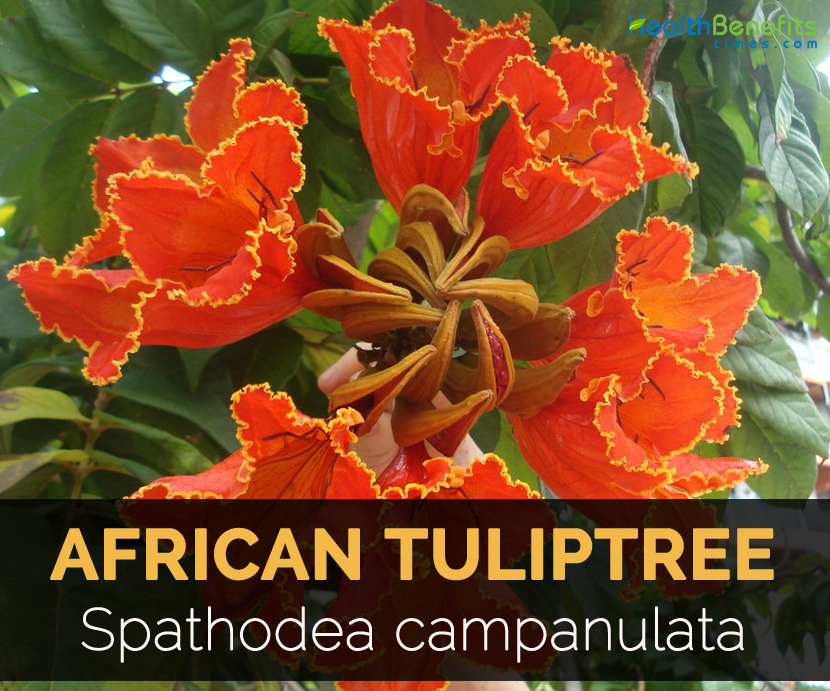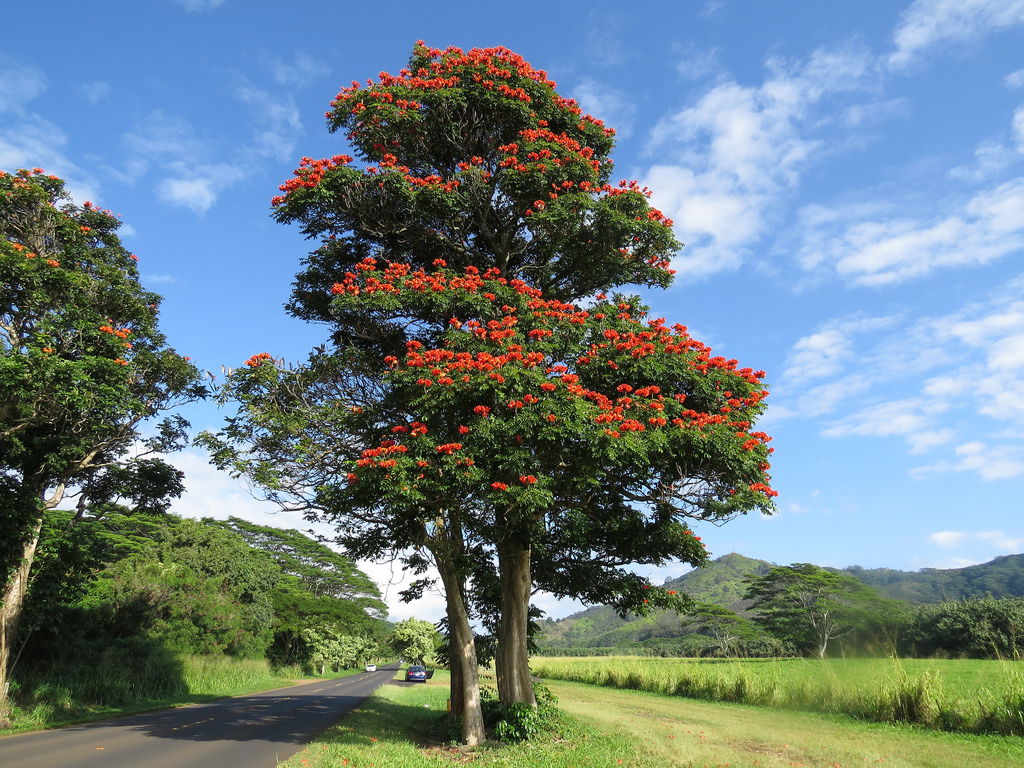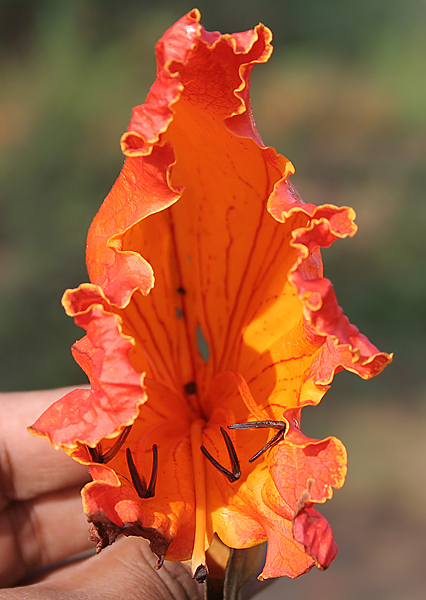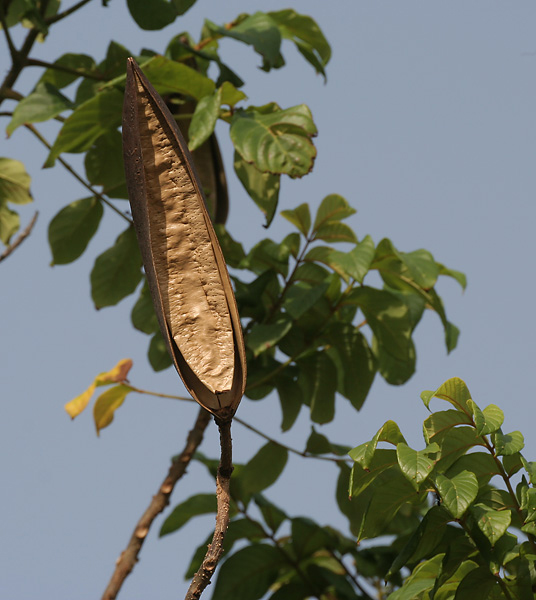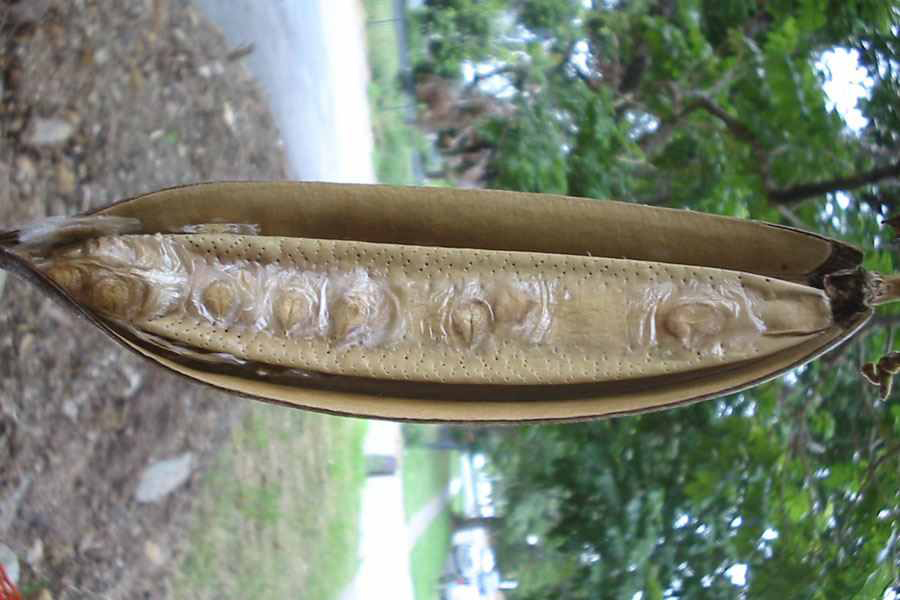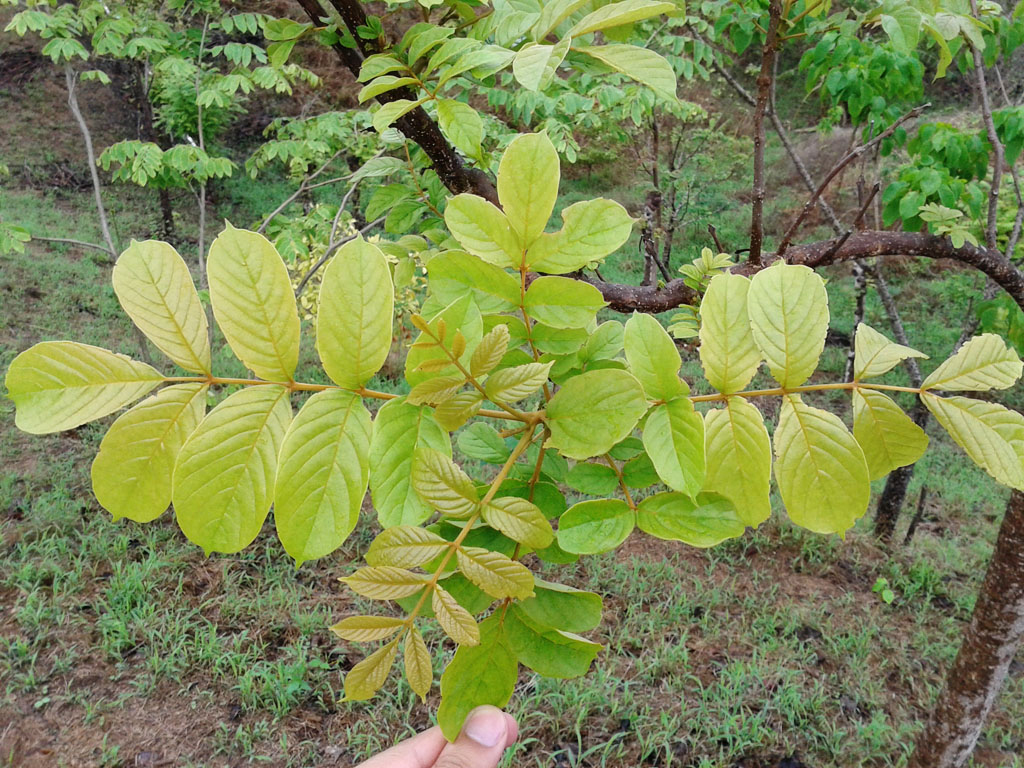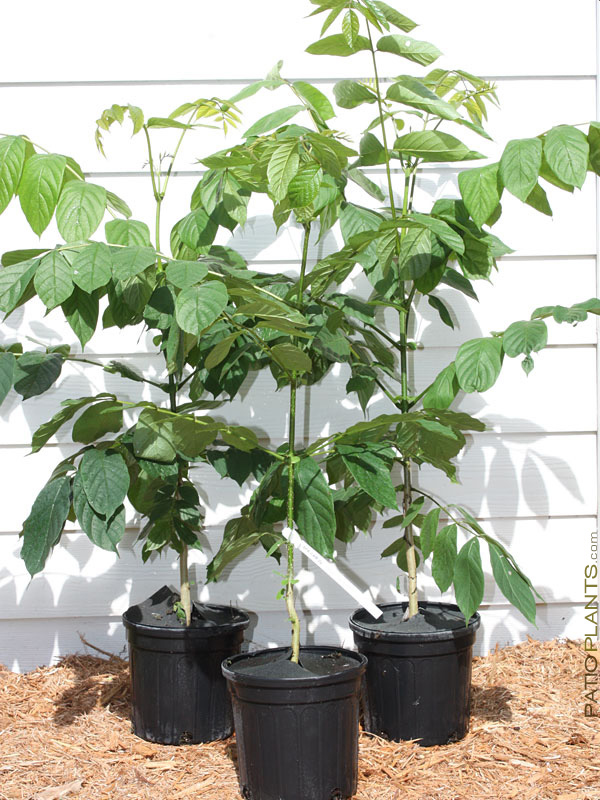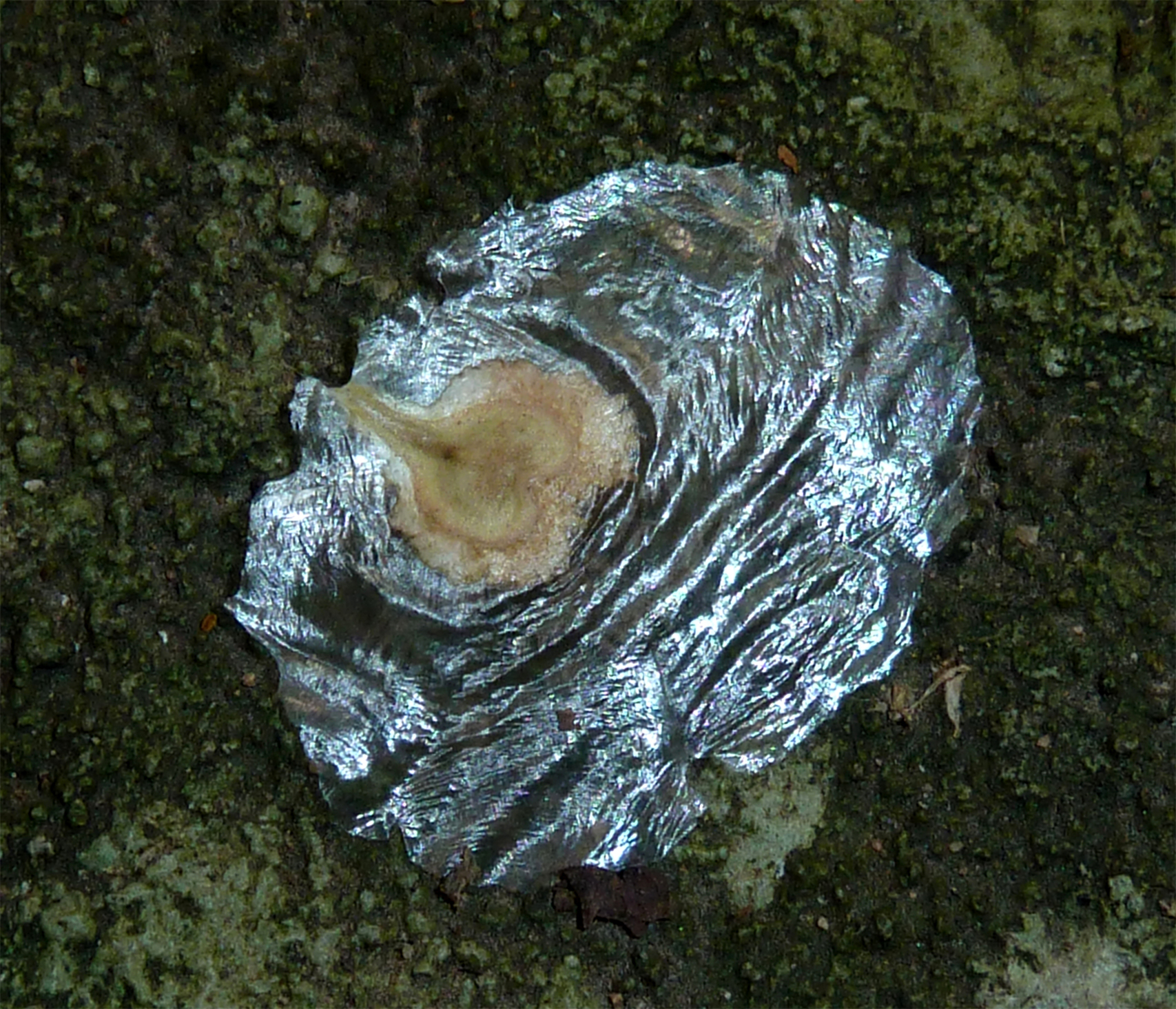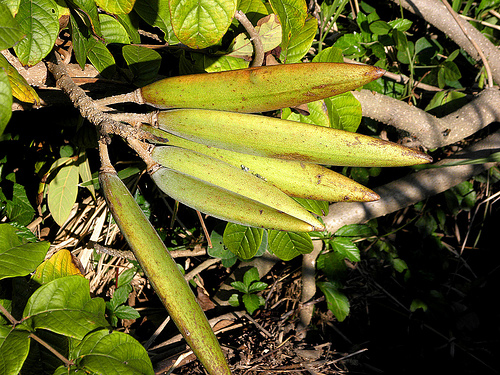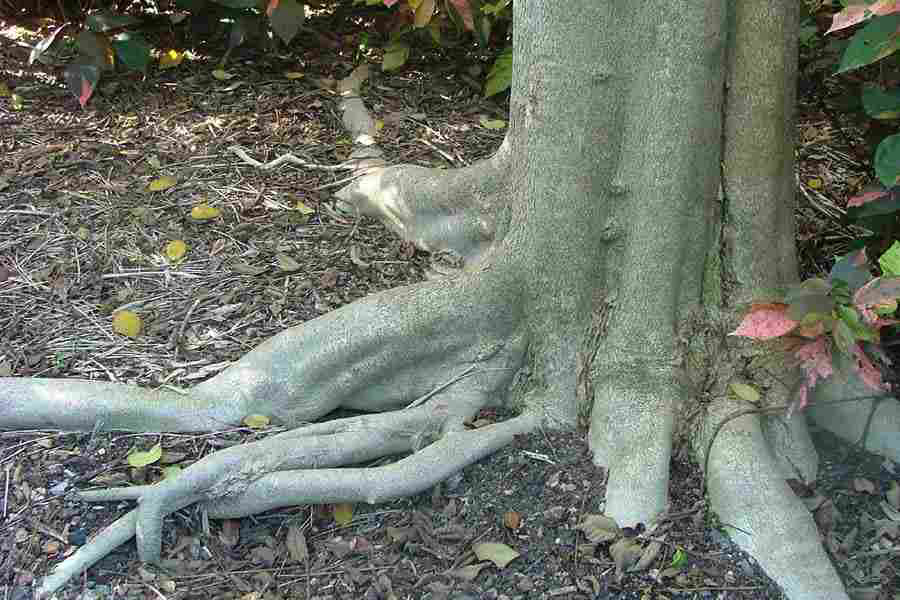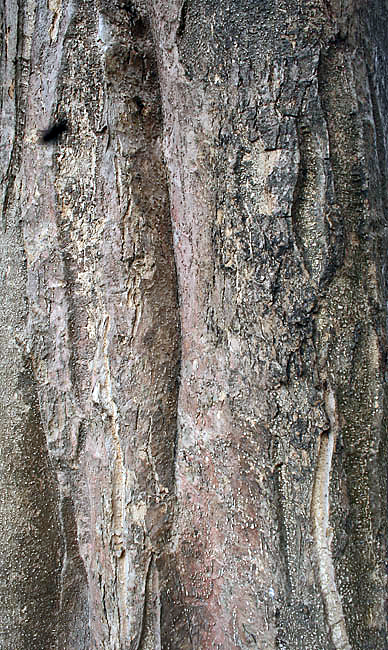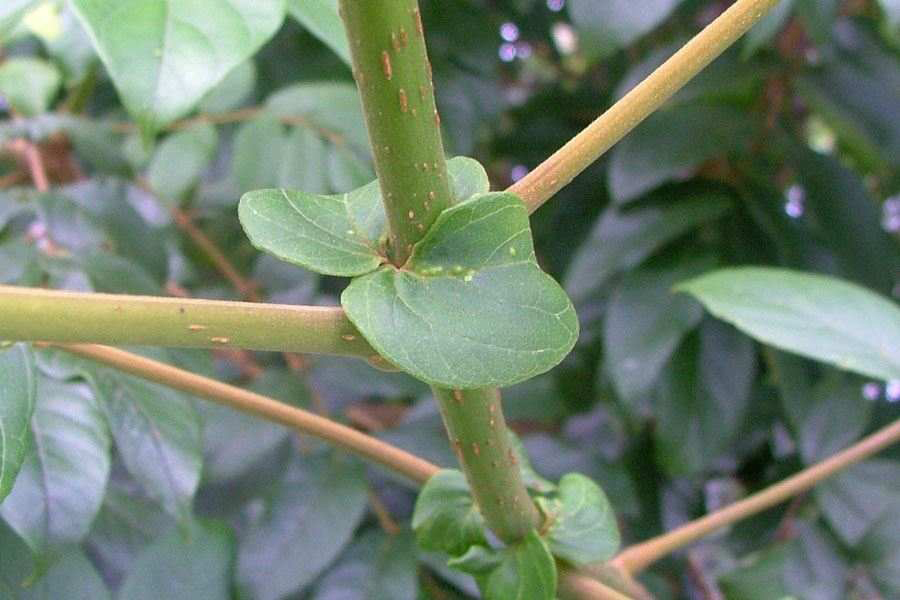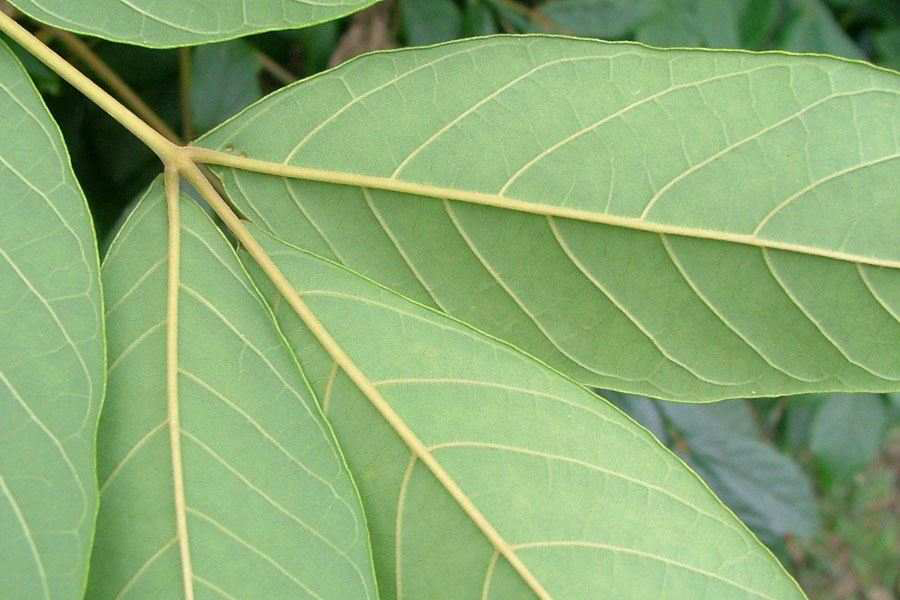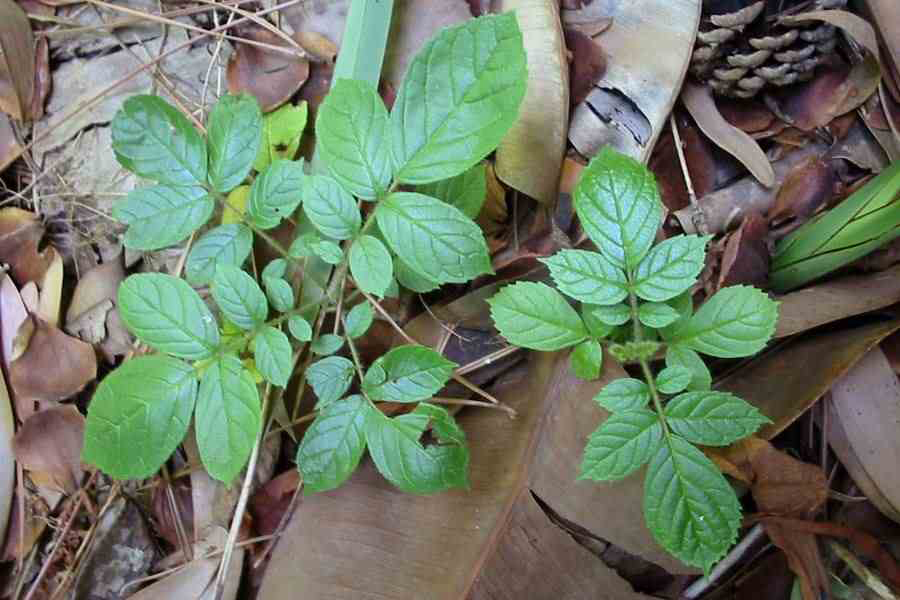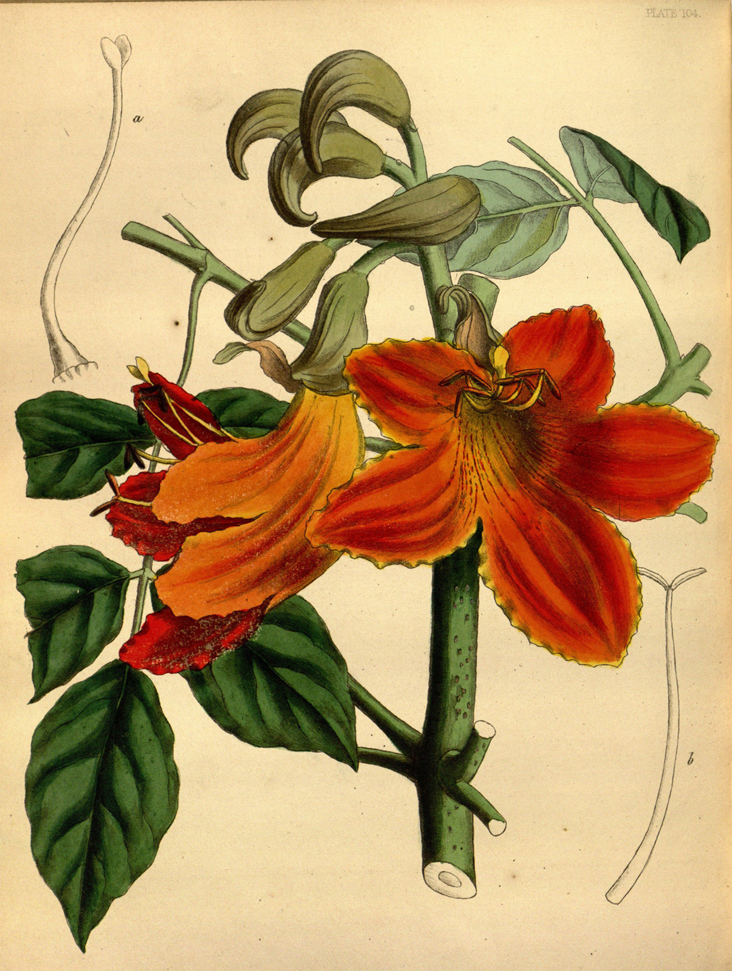African tulip tree is inherent to tropical Africa. It is well-known as street tree or ornamental garden tree in tropical and subtropical parts of Queensland as it bears showy red tulip shaped flowers. In North Queensland, African tulip trees are a serious environmental weed, where they are highly invasive and form dense stands in gullies and along streams. It has become a problem in south-east Queensland as environmental weeds. The tree reproduces by seeds and suckers and is able to spread from a single planting.
Plant
Spathodea campanulata is a deciduous, perennial and medium sized tree which reaches 10 to 25 meters in height with compact, round crown of dense and dark green foliage, buttressed, stout trunk and thick lenticellate branches. Bark when young is pale grey-brown, smooth which turns to grey-black, scaly and fissured horizontally and vertically with age. Leaves are imparipinnate, exstipulate and opposite. Each leaf consists of 5 to 7 pairs of opposite leaflets and petioles about 7 to 15 cm long. The leaflets are elliptical to ovate or ovate to oblong measuring 7 to 16 cm by 3 to 7 cm with entire margin and asymmetrically truncate to cuneate base, acute or acuminate base. Flowers are zygomorphic, hermaphrodite, showy and large with pedicles upto 6 cm long. Fruit is a narrow ellipsoid capsule about 15 to 27 cm by 3.5 to 7 cm in blackish brown. Seeds are thin, flat, broadly winged and 1.5 cm by 2 cm.
Stem and leaves
Branches are thick and are marked with small whitish colored corky spots. Younger branches are almost hairless to having sparse covering of small hairs. Large leaves are compound upto 50 cm long with 7 to 17 leaflets. Leaves are arranged oppositely on stems and are borne on stalks upto 6 cm long. Leaflets are egg shaped, broadly oval in outline and have entire margins.
It has sparse covering of soft hairs and the extension of leaf stalk is covered usually with brownish colored hairs. There are two to three tiny raised structures at the base of each leaflet.
Flowers and fruits
Flowers are large, showy and are arranged on dense clusters of 8 to 10 cm long at the branch tips on stalks of 10 cm long. Individual flowers form on short stalks which are covered in brownish colored hairs. Flowers have sepals which are fused into horn shaped structure that splits along one side as the flowers open. Calyx is distinctive and horn shaped which is curved upward, brownish and somewhat ribbed. Petals are reddish to orange colored and are fused together and resemble the shape of tulip flower. Mouth of the flower measures 7 cm across and possesses several indistinct lobes with crinkled margins which are yellowish in color. Flowering occurs throughout the year but its peak season is during spring. Capsules are large, elongated about 3.5 to 5 cm wide and 17 to 30 cm long that resemble pods. It is slightly flattened and turns from green to brown in color when they mature. They split open when mature and release 500 papery seeds. These seeds are light and are surrounded by translucent membranous wing.
Traditional uses
- The leaves and bark decoction is used to cure rashes and inflamed skin.
- Apply the flowers directly on wounds.
- Leaves infusion is used for urethral infections.
- Apply the fresh inner bark to oozing ulcers.
- The stem bark helps to lower the levels of blood sugar.
- Extracts of leaves, bark and roots is used to treat malaria and HIV.
- Bark is used to treat skin rashes.
- In Africa, the paste made from stem bark is used for healing wounds.
- In Senegal, bruised flowers and leaves are applied to wounds.
- Flowers are used for treating ulcers in Gabon.
- Leaves are used for convulsions in Southern Nigeria.
- The decoction made from bark is used for constipation, dysentery and gastrointestinal problems in Gold Coast.
- The cold infusion made from leaves is useful for urethral inflammation.
- The decoction made from stem bark is used for treating diabetes in Rwanda.
- It is used for kidney diseases in Ayurveda.
- The fluid from immature flower bud is used to cure glaucoma in Jamaican folklore medicine.
- Chew the bark and spray over swollen cheeks.
- Boil the bark in water and use it for bathing newly born babies to treat body rashes.
Other Facts
- It is reproduced by seeds, cuttings and root suckers.
- African Tuliptree could reach 50 to 60 feet high and 40 feet wide.
- The tree has pinnate leaves which comprise of 7 to 17 elliptical leaflets. Leaves are arranged oppositely on branches.
- It blooms orange to red flowers which are arranged in bell shaped clusters at the end of branches. The tree bears flowers having both types of reproductive organs.
- The tree blooms flowers all year round but flowers lasts for three days only. Flowers are the rich source of nectar which attracts hummingbirds and they are responsible for the pollination.
- The green pods comprise about 500 seeds. The ripe pods are brown colored.
- In Africa, seeds are used as the part of human diet.
- The open pods are woody and boat shaped.
- Due to large quantities of water accumulated inside flower buds, African Tuliptree is also known as fountain tree.
- African Tuliptree has weak branches and shallow root system.
- The wood of African Tuliptree is light brown and is used for manufacture of drums, paper and for carving.
- It is a perennial plant which could survive from 50 to 150 years in wild.
References:
https://www.itis.gov/servlet/SingleRpt/SingleRpt?search_topic=TSN&search_value=34342#null
https://davesgarden.com/guides/pf/go/2404/
https://weeds.brisbane.qld.gov.au/weeds/african-tulip-tree
http://herbs-treatandtaste.blogspot.com/2012/02/african-tulip-tree-one-with-many-uses.html
http://www.softschools.com/facts/plants/africa_tulip_tree_facts/2103/
http://www.stuartxchange.org/TulipTree.html
http://florawww.eeb.uconn.edu/199200447.html
https://keyserver.lucidcentral.org/weeds/data/media/Html/spathodea_campanulata.htm
Comments
| African Tuliptree Quick Facts | |
|---|---|
| Name: | African Tuliptree |
| Scientific Name: | Spathodea campanulata |
| Origin | African Tulip Tree is inherent to West and Central Africa and western East Africa: Angola, Ethiopia, Democratic Republic of Congo, Ghana, Kenya, Sudan, Tanzania, Uganda and Zambia. |
| Colors | Blackish brown |
| Shapes | Narrowly ellipsoidal woody capsule, 15 to 27 cm by 3.5 to 7 cm |
| Health benefits | Cure rashes and inflamed skin, Lower blood sugar levels, Treat ulcers, Treat diabetes, Cure glaucoma |
| Name | African Tuliptree |
|---|---|
| Scientific Name | Spathodea campanulata |
| Native | African Tulip Tree is inherent to West and Central Africa and western East Africa: Angola, Ethiopia, Democratic Republic of Congo, Ghana, Kenya, Sudan, Tanzania, Uganda and Zambia. |
| Common/English Name | African Flame Tree, African Tuliptree, African Tulip Tree, African-Tuliptree, Firebell, Fireball, Fire Tree, Flame of the Forest, Flame Tree, Flame-of-the- Forest, Indian Cedar, Fountain Tree, Nandi Flame, Pichkari, Nile Flame, St. Dominic’s Mahogany, Nandi Flame, Santo Domingo Mahogany, Squirt Tree, Scarlet Bell Tree, Tuliptree, Ugandan Flame, Nandi flame, Firebell |
| Name in Other Languages | Afrikaans: Afrikaanse Vlamboom, Vlamboom; Benin:- Fon, Goun: Adada, Vikissè, French: Tulipier Du Gabon, Yoruba: Orourou, Brazil: Espatódea, Bisnagueira, Tulipeira-DaÁfrica; Burmese: A-Hpa.Ri.Ka. Kyu:Lis; Cameroon:- Ewondo: Evovone, Mafou: Bamileke; Carolinian: Apär; Columbia: Tulipán Africano; Cook Islands:- Maori: Kō’Ī’Ī, Mata Kō’Ī’Ī, Kō’Ī’Ī, Mimi, Pātītī Vai, Patiti Vai, Pititi Vai, Cote D’ivoire:- Abe: Boro, Abure: Kokomayur, Agni: Asrélé, Akan-Asante: Sinséré, Aye: Kotchu, Sé, Anyi: Asrélé, Baoulé: Biébié, Biébié Sirili, Biébié Biébié, Diébéserélé, Gagu: Vovo, Guer e: Zabré, Pautu, Zéblé Zébré, Kru- Bété: Zéblé Zébré, Zibli, Kyama: Gbagbihia, Manding- Dioula: Missiboiri, Tiéré, Maninka: Kokwè, Senufo-Tagwana, Tagouana: Assien, Shien: Zéblé Zébré; Cuba: Espatodea; Danish: Afrikansk Tulipantræ; Democratic Republic Of Congo:- French: Tulipier Du Gabon, Kiboa: Mbika, Kikongo: Zowa-Zowa, Kilur: Aro, Kilendu: Rruu, Kinande: Mbina, Kinyarwanda: Igifuratura, Kirega: Isalasala, Kiyanzi: Bobo, Lokele: Oteko, Mashi: Langalanga, Turumbu: Oteko, Kuon-Kusu; Dominican Republic: Amapola, Mampolo; Dutch West Indies: Tulpenboom; Eastonian: Kellukspatoodea; Esperanto: Spatodeo; Fijian: Taga Mimi; French: Arbre-Flamme, Immortel Éntranger, Baton Du Sorcier, Pissat De Singe, Pisse-Pisse, Pisse L’eau, Tulipeira-Do-Gabão, Tulipier Du Gabon; Gabon:- Apindji: Tsogolo, Bakèlè: Asuba, Akondo- Kondo, Banzabi: Mutsongo, Bavarama, Bavungu, Eshira: Muntsogu, Bapunu: Mutsongo, Mutsotsogu, Bavili: Muyayaga, Benga: Éhuba, Béséki: Isubo, Fang: Évung-Vunghe, Évunghele-Vunghele, Galoa, Mpongwè, Nkomi, Orungu: Ntsogo, Ivéa, Ngowé: Tsogo, Loango: Nyinga, Masango: Mulèlè, Mulèlè-Kusu, Mindumu: Ndjobi- Likoto, Mitsogo: Égombé, Gambia:- Fula-Pulaar: Sukunde, Manding-Mandinka: Sula-Selo; German: Spathodea, Afrikanischer Tulpenbaum, Telpenbaum; Ghana:- Adangme: Edumanki, Vot∫O, Akan- Asante: Akuσkσ, Akuakuo Ninsuo, Kσkσ-Anidua, Asante-Twi: Kookoo Nisua, Kuokuonesuo, Baule: Biebie, Gbe-Vhe: Adadase, Adatsigo, Kwawu: Osisiri, Senufo-Tagwana: Abeni, Twi: Akuakuo- Ninsuo, Akuakuaninsu, O-Sisiriw, Wasa: Osisiri; Guinea:- Fula-Pulaar: Diapélédé, Sukunde , Manding-Maninka: Tunda, Guinea-Bissau:- Balanta: Pikeriko, Piquério, Fula-Pulaar: Cafauano, Sekunde, Culassaque, Suncúndè, Mandémg- Mandinka: Sula-Selô, Pepel: Teme; Haiti: Immortel Éntranger; India:- Bengali: Rudra Palash (রুদ্রপলাশ), Kannada: Lujjekaye, Ucche Kaayi, Neerukaye, Marathi: Pichkari, Tamil: Patadi, Telugu: Patade, Patadiya; Indonesia: Kecrutan, Sepatu Diat, Ki Engsrot, Kenya: Sebetaiyat; Laotian: Khae Daeng; Luganda: Kifabakazi; Malaysia: Pancut-Pancut; Mexico: Flamboyán, Galeana; Nigeria:- Bokyi: Kenshie, Edo: Ókuèkuè, Ókwèkwè, Efi k: Èsèńnīm, Ejagham: Ekok, Igbo: Akpoti, Ogbolo Ḿmìrì, Ímí Éwū, Oruru, Ugwogo, Mbembe: Okiníkene, Mungaka: E-Nko Nebang, Yoruba: Mójútòrò, Orórù; Palauan: Orsachel Kui; Pohnpeian: Tuhke Dulip, Dulip En Aprika, Polish: Tulipanowiec Afrykański; Polynesia: Pisse LʻEau; Popular Republic Of Congo:- Akwa: Voulou, Koukouy a: Ontsountsoko, French: Tulipier Du Gabonn; Portuguese: Espatódea, Bisnagueira, Tulipeira-Da-África; Puerto Rico: Meaito; Samoan: Fa’Apasi, Tulipe; Senegal:- Balanta: Blalo, Banyun: Sisal, Konyagi: A-Tyilil, Serer: Mam, Wolofé: Fèr, Fèhr, Tidômô; Sierra Leone:- Manding- Maninka: Dumεntili, Dundunturi, Mende: Baine, Gele-Gσ, Gobane, Tombo-Lεmbi, Ngele Gσwσ, Tombo, Lεmbi, Temne: A-Leop-A-Ro-Bath; Spanish: Espatodea, Mampolo, Amapola, Tulipán Africano, Árbol De La Fontana, Llama Nandi, Llama-Del-Bosque, Árbol De La Fontana, Llama-Del-Bosque, Árbol De La Fontana, Llama Nandi, Llama-Del- Bosque, Tulipan Africano, Llama Nandi, Tulipán De África, Tulipero Del Gabón; Sri Lanka: Kudulu, Kudaella Gaha; Swahili: Kifabazakazi, Kibobakasi; Swedish: Afrikanskt Tulpanträd; Thai: Khae-Saed; Togo:- Fon: Dudu, Ewé: Datsigolo, Dadassé, Adatsigolo, French: Tulipier Du Gabon, Gbe-Vhe: Adadase, Gbetachi- Gbetschi; Tongan: Tiulipe; Tongarevan: Tiale Akapisipisi, Tiare Akapisipisi; Uganda: Munyalisha; Vietnamese: Hồng Kỳ, Chuông Ðỏ, Sò Ðo Cam; Venezuela: Gallito, Caoba De Santo, Tulipán Africano; West Cameroons:– Duala: Bwèle Ba Mbonjì, Kpe: Mbako, Kundu: Etoto, Etutu; Yapese: Ramingobchey; Bengali: Rudra palash (রুদ্রপলাশ ); Chinese: Huǒ yàn shù (火焰樹), Huǒyàn mù (火焰木), Cū yè jiǔ píng shù (槭葉酒瓶樹), Ào zhōu huǒ yàn shù (澳洲火焰樹); English: African tulip tree, Flame of the forest, Fire bell, Flametree, Scarlet bell flower, Fountain tree, Tuliptree; French: Tulipier du Gabon; German: Afrikanischer Tulpenbaum; Hindi: Rugtoora (रगतूरा); Japanese: Kaenboku (カエンボク), Kaen boku (火焔木); Kannada: Neerukayi mara; Malay: Panchut-panchut; Malayalam: Phaauntanmaram (ഫൗണ്ടന്മരം), Sphaathhoodiya (സ്പാഥോഡിയ), Sukoottamaram (സ്കൂട്ട്മരം); Marathi: Akash shevga (आकाश शेवगा); Portuguese: Bisnagueira, Espatódea, Tulipeira-da-África; Russian: Spatodeia kolokol’chataia (Спатодея колокольчатая); Sinhalese: Kudulu, Kudaella gaha; Spanish: Amapola, Mampolo, Espatodea, Tulipán africano; Swahili: Kifabakazi, Kibobakasi; Swedish: Afrikanskt tulpanträd; Tamil: Patadi; Thai: Kae sàet (แคแสด); Catalan: Arbre de les tulips, Arbre de les tulipes africà; Finnish: Tulppaanitrumpetti; Palauan: orsachel kui; Pohnpeian: tuhke dulip, dulip en Aprika; Samoan: fa‘apasī, tulipe, fa‘apasī, tulipe; Yapese: ramingobchey; Uganda: kibobakasi, sebetaiyet, kifabakaz |
| Plant Growth Habit | Deciduous perennial tree |
| Plant Size | 10 to 25 meters |
| Flowering Season | Late Winter/Early Spring |
| Buds | Ampule-shaped |
| Flower | Reddish-orange or crimson |
| Fruit shape & size | Narrowly ellipsoidal woody capsule, 15 to 27 cm by 3.5 to 7 cm |
| Fruit color | Blackish brown |
| Seed | Thin, flat, 1.5 cm by 2 cm, very broadly winged |


